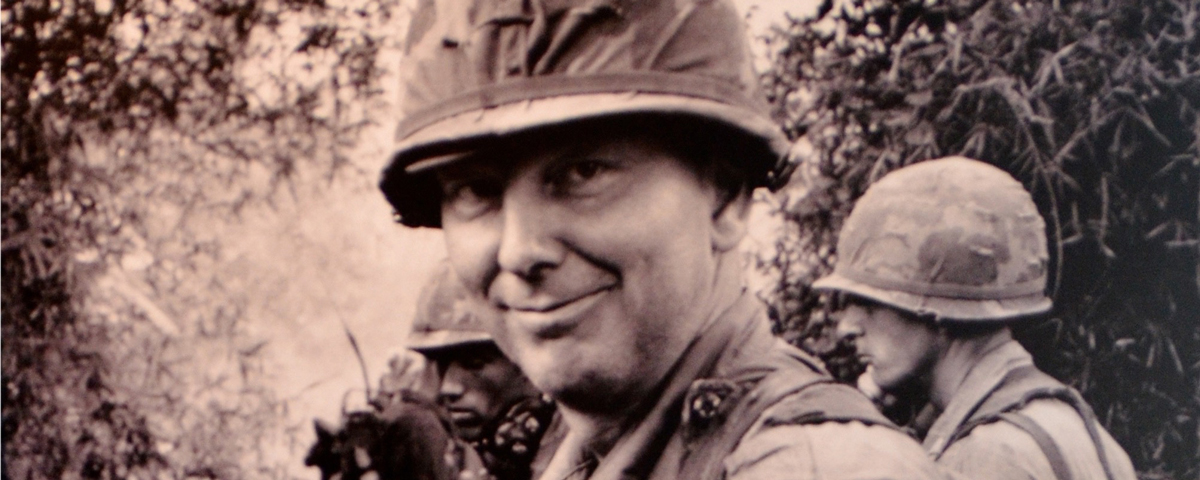Reporting Vietnam, Newseum exhibit, 555 Pennsylvania Ave. NW, Washington, D.C., runs through Sept. 12, 2016
The Newseum, the interactive museum of news and journalism, opened its newest exhibit, “Reporting Vietnam,” on May 22 to commemorate the 50th anniversary of the Vietnam War. The first display panel gets right to the point: Did the press lose the war in Vietnam? And two accompanying quotes set the parameters of the debate:
“Press and television had created an aura not of victory but of defeat.”
—General William Westmoreland, commander U.S. forces, Vietnam
“It was not our war to win or lose, but it was our war to understand and to explain.”
—Fred Friendly, CBS News president
The Newseum, funded by the Freedom Forum, a foundation set up by USA Today founder Al Neuharth, states that its mission is to “help the public and news media understand one another better.” It is evident that the Newseum has taken great care with this exhibit as it navigates the complex and controversial battleground of Vietnam history and memory.
The exhibit features interviews with dozens of reporters and photographers who covered Vietnam, as well as General Barry MacCaffrey, a former company commander in the 1st Cavalry Division (Airmobile); war scholars Dan Hallin and Todd Gitlin; and William Hammond, a former senior historian at the Army’s Center of Military History.
Hammond, in his two authoritative volumes The Military and the Media, concludes, “The American people followed their own, third course, marked by independence of judgment and a substantial measure of contempt for all those who sought to manipulate the public mind.”
“Reporting Vietnam” is boldly designed and dramatically lit. I was a war correspondent in Vietnam for ABC and NBC, and it is strange to see Vietnam reporters’ tools—almost 100 of the “things we carried” like cameras, helmets and typewriters—referred to as “artifacts of history,” remnants and curiosities of the past. There are more than 100 images of newspapers, magazines and photographs, including many Pulitzer Prize winners, some enlarged to an impressive size.
The Newseum produced three continually running films that incorporate Vietnam archives and recent interviews with the press and military. One shows how television changed the way we received most news from the battlefield. Although many believe graphic footage from the war contributed to the breakdown of public support, the film explains that TV news largely sanitized the war, rarely showing violent combat. Another film examines the protest movement at home. And on a 100-foot-long “big screen,” a third one highlights the war’s crucial moments with dozens of images displaying at once. Throughout the exhibit, visitors hear a soundtrack of the songs that came to represent the fight and the protest.
In one exhibit panel, Time magazine reporter Charles Mohr tells us that editors in New York changed his wording “The war in Vietnam is being lost” to “Government troops are fighting better than ever.” Mohr quit the magazine in protest.
Many panels describe the dominance of the Associated Press in Vietnam: “The AP was unmatched in its expertise and depth of coverage.” There is an edition of AP journalist Mal Browne’s “A Short Guide to News Coverage in Vietnam,” a primer for inexperienced reporters. It probably saved many lives, including mine, with its advice on how to cover combat and survive.
A panel on CBS reporter Morley Safer, who produced a controversial report showing Marines torching the village of Cam Ne, includes a letter from a TV viewer addressed to “Morley Safer, CBS traitor.” CBS anchor Walter Cronkite merits a panel on his change in views about the war. President Lyndon B. Johnson reportedly told an aide, “If I’ve lost Cronkite, I’ve lost middle America.” But, says the Newseum text, “Cronkite’s editorial did not so much create public doubt as reaffirm it.”
Journalists are taken to task on coverage of the war protest movement. One display on the war at home includes these words: “Media mocks Pentagon war protesters. As protests spread, press coverage remained generally negative. News coverage focused on drug use and disorderly conduct.” The exhibit notes that public opinion turned against the war before most newspaper editors did.
Wars are fought twice, once on the battlefield and later in the remembering. And so it is with the Vietnam War, though it ended on the battlefield four decades ago. But the Newseum has created a remarkably unbiased assessment of the media’s role in the war while raising public awareness of the importance of a free press in a democratic society.
—Don North






